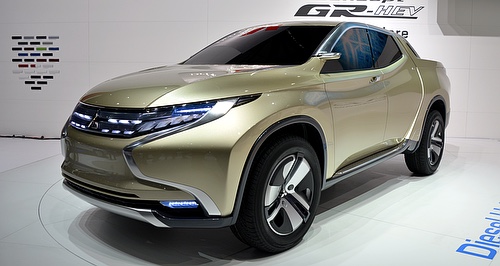Future models - Mitsubishi - Triton - PHEVElectrified Triton development well advancedNew Mitsubishi Triton to lack electrified option from launch but stay tuned for PHEV24 Oct 2022 By TONY O'KANE in JAPAN WHILE a new generation of conventionally-powered Mitsubishi Triton range is on track to launch in the next year or so, development on an electrified derivative remains in the prototype phase with a market introduction for Mitsubishi’s first electrically-augmented utility not expected until after 2025.
And while interest in fully-electric utilities is running hot right now, as evidenced by sellout performance of the Ford F-150 Lightning in the USA and the impending Aussie arrival of the LDV eT60, Mitsubishi Motors Corporation (MMC) is not sold on the idea of making its workhorse ute a full-fledged EV just yet.
MMC general manager of EV powertrain engineering,Takashi Shirakawa, told GoAuto an electrified powertrain “is in advanced engineering already for Triton and Pajero Sport products, but from a CO2 reduction viewpoint a battery-electric is not a good answer”.
“We are thinking about whether hybrid is better, plug-in hybrid is better or pure electric is better, and we have those products in prototypes and we are comparing them, but our headache is always, always cost.”
With a large component of an electric vehicle’s cost being its battery, the ‘electric premium’ associated with putting a motor and high-voltage battery into a vehicle scales in proportion to the capacity of that battery pack.
Given the current-generation Triton weighs around two tonnes, depending on variant, adding another few hundred kilograms of battery and motor mass to turn it into a pure EV would also introduce other compromises in terms of handling, ride and payload.
Mitsubishi’s current ethos is to preference a plug-in hybrid (PHEV) configuration for its larger vehicles, and it seems that a PHEV flagship would be the most likely outcome for the next-generation Triton.
Besides being able to get away with a smaller-capacity battery (which helps keep costs and weight gain to manageable levels), the additional flexibility of being able to be driven on combustion power when the electrons run out presents a better fit for markets like Australia.
MMC also sees PHEVs as being the most environmentally-conscious option when considering the full lifecycle emissions of a vehicle – the CO2 emitted not only during the vehicle’s operation, but also during its manufacturing and disposal.
With pure EVs requiring significantly more energy to build than a PHEV, Mitsubishi says plug-ins are kinder to the environment overall.
For the new Triton, which is expected to be built in Thailand (whose electricity infrastructure is one of the most CO2-intensive in the world), pursuing a less energy-demanding powertrain would be critical to maintaining environmental credibility.
Mr Shirakawa also stated that the electrified Triton could boast some clever torque-vectoring capabilities versus a conventional diesel powertrain and 4x4 driveline.
“Electrification gives a customer benefit like manoeuvring in difficult conditions – electrification can enable some extra driving (capabilities). So we are thinking about how to make electrified larger vehicles, but it is still under advanced engineering.”
Mitsubishi already equips its recently-launched Outlander PHEV with a pair of household power outlets and bi-directional charging (which allow the energy stored within the car’s 20kWh battery to be used on electric tools, appliances and other 240V appliances).
Such tech would also likely equip the electrified Triton – a boon to tradies who need to keep cordless tools charged up while on the worksite and weekend warriors wanting to keep their provisions cool and campsites illuminated.
But when can we expect to see it? Mr Shirakawa said more work needs to be done on the engineering side first. The deadline for an electrified Triton is the end of this decade, by which time the as-yet unreleased next-generation model would be approaching the tail-end of its lifespan
When asked if he and his team could finalise a new partially-electric powertrain for the Triton before the end of 2025, Mr Shirakawa said it would likely take a little more time than that to bring an electrified Triton to market.  Read more7th of October 2022  Mitsubishi debuts limited-edition Triton SportMore visual makeover than hardcore off-roader, but a sub-60k bargainTriton pricing
Motor industry news |
Click to shareMitsubishi modelsResearch Mitsubishi Triton pricing
Motor industry news |
















Facebook Twitter Instagram